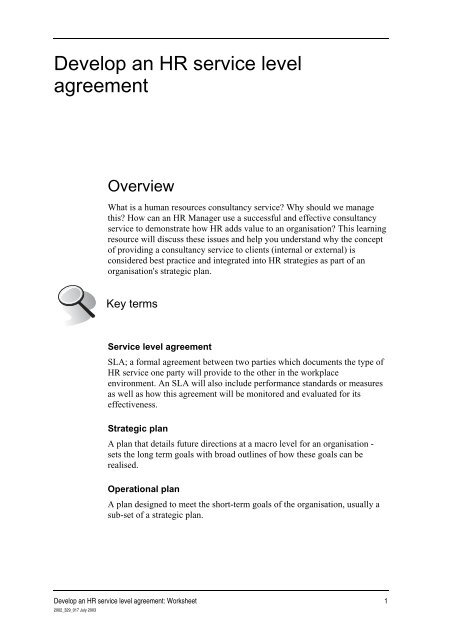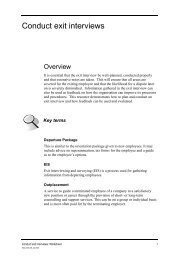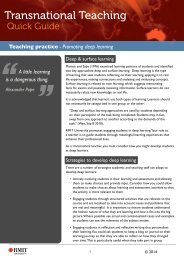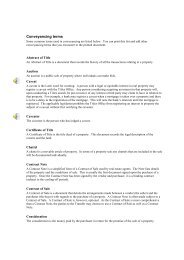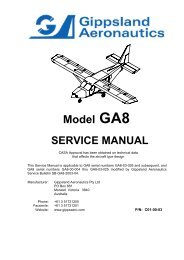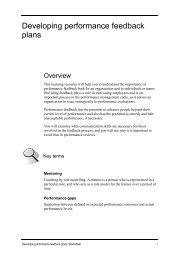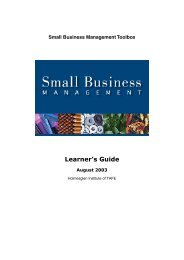Develop an HR service level agreement - Flexible Learning Toolboxes
Develop an HR service level agreement - Flexible Learning Toolboxes
Develop an HR service level agreement - Flexible Learning Toolboxes
You also want an ePaper? Increase the reach of your titles
YUMPU automatically turns print PDFs into web optimized ePapers that Google loves.
Think• In what ways c<strong>an</strong> <strong>an</strong> <strong>HR</strong> function add value to <strong>an</strong> org<strong>an</strong>isation's corebusiness?• What would be the impact on the current <strong>HR</strong> staff in <strong>an</strong> org<strong>an</strong>isationthat decides to ch<strong>an</strong>ge from <strong>an</strong> <strong>HR</strong> department to <strong>an</strong> internal <strong>HR</strong>consult<strong>an</strong>cy model?• What strategies could be used to sell the concept of <strong>an</strong> internal <strong>HR</strong>consult<strong>an</strong>cy <strong>service</strong> to:o line m<strong>an</strong>agers <strong>an</strong>d supervisorso senior m<strong>an</strong>agers <strong>an</strong>d CEOo <strong>HR</strong> staff (who may not yet be comfortable with the movefrom policy watchdog to business partner)?The role of the <strong>HR</strong> consult<strong>an</strong>t vs. line m<strong>an</strong>agerWhen <strong>an</strong> <strong>HR</strong> consult<strong>an</strong>t is working closely with a line m<strong>an</strong>ager on dealingwith a particular issue/s, line m<strong>an</strong>ager may ask them to deal with the issuesthemselves."C<strong>an</strong> you please h<strong>an</strong>dle this recruitment for me?""C<strong>an</strong> you just have a chat to this person <strong>an</strong>d let them know where they'regoing wrong?""C<strong>an</strong> you please run this meeting for me <strong>an</strong>d explain to my m<strong>an</strong>agers whatwe'll be doing?"In all of these requests, there is the d<strong>an</strong>ger of the <strong>HR</strong> consult<strong>an</strong>t falling intothe trap of doing the work for the line m<strong>an</strong>ager. What is import<strong>an</strong>t toremember that as a consult<strong>an</strong>t, you are there to provide guid<strong>an</strong>ce, advice<strong>an</strong>d recommendations including r<strong>an</strong>ge of options that the line m<strong>an</strong>ager maytake into consideration when he/she makes their decision - but essentiallyyou are not usually the decision maker.4 <strong>Develop</strong> <strong>an</strong> <strong>HR</strong> <strong>service</strong> <strong>level</strong> <strong>agreement</strong>: Worksheet2002_329_017 July 2003
Think• How could you get the line m<strong>an</strong>ager to make the decisions <strong>an</strong>dimplement the ch<strong>an</strong>ges instead of you whilst maintaining <strong>an</strong>effective working relationship with them?• What strategies would you need to adopt to ensure this does not reoccurwith that particular line m<strong>an</strong>ager?Consulting as a processDepending on the nature of the <strong>service</strong> you are providing to a line m<strong>an</strong>ager,your processes of consulting may vary slightly, or some parts may be morecomplex th<strong>an</strong> others.Generally, most consulting assignments should be approached in amethodical, structured way - remember that Prior Preparation <strong>an</strong>d Pl<strong>an</strong>ningPrevents a Poor Perform<strong>an</strong>ce! The secret to developing a good pl<strong>an</strong> is totake the time to ensure that you have considered as much information aspossible in developing your time lines <strong>an</strong>d the project scope - this willensure that you c<strong>an</strong> deliver on-time.Whilst there are numerous consulting models around, generally they followa similar theme:1. Contracting2. Assessment3. Pl<strong>an</strong>ning4. Implementation5. EvaluationStep 1: Contracting - covers the initial broad scope of the assignment. Inthis step expectations <strong>an</strong>d roles of both the client <strong>an</strong>d the consult<strong>an</strong>t areclarified, as well as the working arr<strong>an</strong>gements negotiated.Step 2: Assessment - where the consult<strong>an</strong>t gathers all the information <strong>an</strong>ddata required to fully comprehend the assignment.Step 3: Pl<strong>an</strong>ning - covers the development of the action pl<strong>an</strong> by theconsult<strong>an</strong>t, which includes pl<strong>an</strong>ning timelines, <strong>an</strong>d decisions regarding whoin the org<strong>an</strong>isation they will need to liaise with are determined.<strong>Develop</strong> <strong>an</strong> <strong>HR</strong> <strong>service</strong> <strong>level</strong> <strong>agreement</strong>: Worksheet 52002_329_017 July 2003
knowledge <strong>an</strong>d advice will ensure that your client has access to a variety ofsolutions from which they c<strong>an</strong> make informed decisions.For more complex problems, it may be appropriate to use one of the morerecognised quality tools such as the Ishikawa. <strong>Develop</strong>ed by Dr Ishikawawho helped pioneer the quality movement in Jap<strong>an</strong>, this tool is effective indefining causes <strong>an</strong>d developing strategies to overcome these.Figure: Fishbone diagram showing how to org<strong>an</strong>ise major & minor aspects of aproblemMajor aspectsof problemMajor aspectsof problemMajor aspectsof problemWhat theproblem isMajor aspectsof problemMajor aspectsof problemMajor aspectsof problemAbove is the Ishikawa model, or "fishbone". At the "fish's nose" is whereyou write what the problem is, <strong>an</strong>d on each of the "fishbones" you list whatthe major aspects of the problem are. These could be issues such as poorcommunication, lack of adequate resources, staff lacking a team approachetc.Once you have listed the major aspects of the problem, you are then in aposition to list a number of strategies to address these particular aspects ofthe problem - these get included along each of the "fishbones". Once thishas been completed for each of the major aspects, you will then haveavailable a variety of strategies for consideration to assist in dealing withthe problem.This model is particularly useful when solving problems with a group ofstaff, <strong>an</strong>d those staff members who prefer to see things representedpictorially.<strong>Develop</strong> <strong>an</strong> <strong>HR</strong> <strong>service</strong> <strong>level</strong> <strong>agreement</strong>: Worksheet 72002_329_017 July 2003
ScenarioList of what you would need to considersourcing to find out required relev<strong>an</strong>tinformationWhat are the relev<strong>an</strong>t pay rates?Do the org<strong>an</strong>isation's recruitmentprocesses factor in trainee recruitment?You discover a line m<strong>an</strong>ager isworking outside of comp<strong>an</strong>ypolicy on industrial <strong>agreement</strong>swith the number <strong>an</strong>d tenure ofcasual staff. You think that youneed to initiate some workforcepl<strong>an</strong>ning so that their staffingprocesses are more streamlined,efficient <strong>an</strong>d within comp<strong>an</strong>ypolicyA line m<strong>an</strong>ager w<strong>an</strong>ts toimplement a remunerationstrategy to reward <strong>an</strong>d furthermotivate his sales team.A line m<strong>an</strong>ager w<strong>an</strong>ts to use oneof your <strong>HR</strong> consult<strong>an</strong>ts full timefor the next three months to assistthem in process reengineering.Your <strong>HR</strong> consult<strong>an</strong>t has <strong>an</strong>umber of SLAs that she needs toadequately <strong>service</strong> during thistime.A line m<strong>an</strong>ager w<strong>an</strong>ts to recruitstaff on a contract basis in SouthEast Asia. The person will workfor your org<strong>an</strong>isation from SEAsia <strong>an</strong>d will be paid inAustrali<strong>an</strong> dollars.Components of a Service LevelAgreement (SLA)Whilst there are no hard <strong>an</strong>d fast rules about SLAs, it is generally acceptedthat they should contain some essential components to ensure they areeffective:• Scope of <strong>service</strong> to be delivered• Tasks to be completed associated with the scope of <strong>service</strong>• Measures or st<strong>an</strong>dards - both qualitative <strong>an</strong>d qu<strong>an</strong>titative<strong>Develop</strong> <strong>an</strong> <strong>HR</strong> <strong>service</strong> <strong>level</strong> <strong>agreement</strong>: Worksheet 92002_329_017 July 2003
• Monitoring processes• Evaluation processesScope of <strong>service</strong> to be deliveredGenerally, SLAs should detail exactly what <strong>service</strong>s are to be delivered, <strong>an</strong>dto whom. This c<strong>an</strong> cover one or more functions that the client requires <strong>HR</strong>to deliver (internally or externally). This would depend on whether the SLAis written for a whole of org<strong>an</strong>isation, or just one discreet business unit orarea. Eg. An <strong>HR</strong> team may have a general SLA with regard to Recruitment,Selection <strong>an</strong>d Induction of staff that applies to the whole org<strong>an</strong>isation. Inthis case, there would be a series of generic SLAs on each of the <strong>HR</strong>functions performed.Another scenario might be where one area of a comp<strong>an</strong>y is requiring aspecific <strong>level</strong> of <strong>service</strong> in a r<strong>an</strong>ge of <strong>HR</strong> functions that differs signific<strong>an</strong>tlyfrom the rest of the org<strong>an</strong>isation. In this case, the scope of <strong>service</strong> to bedelivered would be more detailed <strong>an</strong>d list a variety of <strong>HR</strong> functions that hadbeen negotiated with this area.ThinkWhat are the adv<strong>an</strong>tages <strong>an</strong>d disadv<strong>an</strong>tages of having generic SLA foreach <strong>HR</strong> function?Tasks to be completed associated with the scope of<strong>service</strong>, <strong>an</strong>d measuresThis section of the SLA should be <strong>an</strong> accurate list of all the tasks that the<strong>HR</strong> area will complete that is associated with the scope of <strong>service</strong>. Thesetasks should contain sufficient detail on the tasks as well as measures. Eg. Ifthe scope of <strong>service</strong> is recruitment, selection <strong>an</strong>d induction of staff, the taskswould list every aspect that <strong>HR</strong> would be involved in for this <strong>service</strong>,including realistic measures:10 <strong>Develop</strong> <strong>an</strong> <strong>HR</strong> <strong>service</strong> <strong>level</strong> <strong>agreement</strong>: Worksheet2002_329_017 July 2003
Table 2: Examples of measures (2 cols)Task to be completedDrafting the advertisementOrg<strong>an</strong>ising the advertisement withnewspapersAnswering queries regarding theposition advertisedSending out recruitment packages toprospective clientsReceiving all applicationsSending out acknowledgment letters toall applic<strong>an</strong>tsConduct initial shortlisting of allapplicationsLiaising with the relev<strong>an</strong>t m<strong>an</strong>ager as towho will be finally shortlistedBooking venues for interviewsArr<strong>an</strong>ging interview scheduleContacting shortlisted applic<strong>an</strong>ts byphone <strong>an</strong>d mail for interviewappointmentsArr<strong>an</strong>ging catering for selection p<strong>an</strong>elArr<strong>an</strong>ging <strong>an</strong>y equipment needed forconducting interviewsProviding <strong>an</strong> administrative support<strong>service</strong> to the p<strong>an</strong>el when interviewingDrafting up a selection reportAdvising unsuccessful applic<strong>an</strong>ts bymailLiaising with successful applic<strong>an</strong>ts toarr<strong>an</strong>ge commencement dateCoordinating <strong>an</strong> induction process forthe new staff memberMeasurewithin 3 days of receiving informationwithin 3 days of receiving informationwithin 24 hours of enquirywithin 24 hours of enquiryBy closing date of advertisementwithin 24 hours of closing date of applicationswithin 3 days of close dateTo be negotiated with the m<strong>an</strong>agerwithin 2 days of receiving final shortlistedapplic<strong>an</strong>tswithin 2 days of receiving final shortlistedapplic<strong>an</strong>tswithin 2 days of receiving final shortlistedapplic<strong>an</strong>tsPrior to day/s of interviewPrior to day/s of interviewTo be negotiated with the m<strong>an</strong>agerwithin 1 week after interviews completedWithin 2 days of selection report finalisationTo be negotiated with the m<strong>an</strong>agerWithin first week of new staff membercommencement<strong>Develop</strong> <strong>an</strong> <strong>HR</strong> <strong>service</strong> <strong>level</strong> <strong>agreement</strong>: Worksheet 112002_329_017 July 2003
Measures or st<strong>an</strong>dardsThese components of the SLA may already have been included in the tasksto be completed section. However, this is where some of the qualitativemeasures c<strong>an</strong> be documented.What also c<strong>an</strong> be included in this component of your SLA is the agreedcommunication <strong>an</strong>d consultation protocols that are negotiated with theclient.Try itCompose a list of possible qu<strong>an</strong>titative <strong>an</strong>d qualitative measures thatcould be documented in this component of <strong>an</strong> SLA.Client responsibilitiesMake clear what are the client's responsibilities as well, for example:• being available to meet with the <strong>HR</strong> team to resolve issues as theyarise• responding to enquires <strong>an</strong>d requests for information within a certaintimeframe• responsibility for <strong>an</strong>y fin<strong>an</strong>cial costs associated with the <strong>HR</strong>activities, eg advertising costs, assessment tools.Monitoring processesThis component covers what monitoring of the SLA is negotiated <strong>an</strong>dagreed to. This c<strong>an</strong> r<strong>an</strong>ge from a simple statement of intent through to acomplex monitoring system. Often SLAs with internal <strong>HR</strong> staff tend to beless complex th<strong>an</strong> SLAs for external <strong>HR</strong> personnel - this c<strong>an</strong> be due to theneed for further complexity as this details the <strong>service</strong> to be provided <strong>an</strong>d thefee charged based on this <strong>service</strong>.An SLA with <strong>an</strong> internal <strong>HR</strong> function c<strong>an</strong> be as simple as a statementdetailing that the <strong>HR</strong> consult<strong>an</strong>t will meet with the line m<strong>an</strong>ager on amonthly basis to review the SLA <strong>an</strong>d provide statistics on <strong>service</strong> providedat these meetings.12 <strong>Develop</strong> <strong>an</strong> <strong>HR</strong> <strong>service</strong> <strong>level</strong> <strong>agreement</strong>: Worksheet2002_329_017 July 2003
Evaluation processesThis component should detail exactly how the <strong>service</strong> is to be evaluated.Depending on what <strong>service</strong> needs to be evaluated will determine thecomplexity of this component of <strong>an</strong> SLA.For example, if the SLA is concerned with Recruitment, Selection <strong>an</strong>dInduction, then the following methods of evaluation may be appropriate:• Questionnaire to all staff recruited seeking feedback on:o <strong>level</strong> of <strong>service</strong> provided to them during <strong>an</strong>d after therecruitment processo timeliness <strong>an</strong>d access to relev<strong>an</strong>t recruitment informationo their induction processo whether the job is what they thought they were applying foro their <strong>level</strong> of satisfaction in the job• Questionnaire to m<strong>an</strong>agers of staff recruited seeking feedback on:o <strong>level</strong> of <strong>service</strong> provided to them by <strong>HR</strong> during therecruitment, selection <strong>an</strong>d induction processo their <strong>level</strong> of satisfaction with the new staff memberrecruitedo whether the selection processes enabled them to recruit theright staff member• Focus groups with m<strong>an</strong>agers across the org<strong>an</strong>isation, seekingfeedback on the <strong>level</strong> of <strong>service</strong> provided, their general <strong>level</strong> ofsatisfaction with the recruitment tools used, etc.What is import<strong>an</strong>t when evaluating SLAs is to ensure that you consider thefeedback received by all parties, <strong>an</strong>d then assess whether it is appropriate tomake ch<strong>an</strong>ges to your SLA based on this. At times you may be dealing withline m<strong>an</strong>agers who may not necessarily wish to follow correct comp<strong>an</strong>ypolicies <strong>an</strong>d processes - this may me<strong>an</strong> that you would need to furtherexplain the rationale behind these in order for them to accept the <strong>service</strong> youprovide.Think• What would some of the challenges be when dealing with linem<strong>an</strong>agers who don't feel it is necessary to always follow comp<strong>an</strong>ypolicy <strong>an</strong>d processes? What steps would you take to deal with these?<strong>Develop</strong> <strong>an</strong> <strong>HR</strong> <strong>service</strong> <strong>level</strong> <strong>agreement</strong>: Worksheet 132002_329_017 July 2003
• If you had a generic SLA for particular <strong>HR</strong> functions <strong>an</strong>d you hadreceived polarised feedback on its perform<strong>an</strong>ce, what would you do?How would you approach each of the people giving you thisfeedback?ReadWhat else is in the contract you agree to with external clients? You mayrefer to:L<strong>an</strong>e S (2003) 'Hum<strong>an</strong> Resource Outsourcing' in Australi<strong>an</strong> MasterHum<strong>an</strong> Resources Guide 2003, CCH, Sydney, Ch 3-130Selling the concept of SLAs to linem<strong>an</strong>agersOnce you have made the decision to implement SLAs - how do you sell thisconcept to your clients ie. your line m<strong>an</strong>agers?Firstly, ensure that you have sufficient consultation time built into yourproject pl<strong>an</strong> in order to sell the concept of SLAs to your clients.It is import<strong>an</strong>t that you don't overlook or underestimate the need to sell thisconcept to your clients. In a work environment where expectations onpeople to perform is ever increasing, new concepts c<strong>an</strong> be viewed assomething that will just take up more of their time. You need to considerwhat's in it for them, <strong>an</strong>d focus on the benefits for them if you are going togain their input <strong>an</strong>d commitment to improvement. This may me<strong>an</strong> having amore personalised, individual approach to selling the concept in the initialstages.The earlier you c<strong>an</strong> involved them in the decision-making processes, thebetter. Most m<strong>an</strong>agers will be less likely to take new initiatives on board ifthe final product is presented to them as a "fait accompli" <strong>an</strong>d they have notbeen consulted regarding the process. One way to involve them early is torun focus groups, or individual meetings to flesh out the concept of SLAs in14 <strong>Develop</strong> <strong>an</strong> <strong>HR</strong> <strong>service</strong> <strong>level</strong> <strong>agreement</strong>: Worksheet2002_329_017 July 2003
order to gain their input. Once you have their input you are more likely tobe successful in them taking some ownership of the content. Besides, youmay receive some valuable feedback as to where your current processesaren't quite meeting their expectations.Consulting early with your clients in the process will also ensure that youc<strong>an</strong> gain their cooperation to adhere to comp<strong>an</strong>y <strong>HR</strong> policy <strong>an</strong>d procedures.This is a great opportunity to explain the rationale behind the processes <strong>an</strong>dclarify <strong>an</strong>y issues they may raise.ThinkYou have developed your SLAs as a result of your consultations withyour clients, <strong>an</strong>d you discover that you have omitted to consult with oneof your m<strong>an</strong>agers. At this stage your SLAs have been endorsed by theCEO, <strong>an</strong>d to make <strong>an</strong>y ch<strong>an</strong>ges would be a little difficult. The m<strong>an</strong>ageris furious that you have omitted him from your process <strong>an</strong>d dem<strong>an</strong>ds tohave a meeting with you to discuss - how would you h<strong>an</strong>dle this?Case studyJill is the newly appointed <strong>HR</strong> M<strong>an</strong>ager at K-Tech Wholesaling, <strong>an</strong>d is nowone of the senior m<strong>an</strong>agers. There has been a ch<strong>an</strong>ge of senior personnel inthe comp<strong>an</strong>y recently through some restructuring which has seen some ofthe "old school" of senior m<strong>an</strong>agers retire or take voluntary redund<strong>an</strong>cypackages. Jill's brief from the CEO on appointment into her new role is to"move into <strong>HR</strong> <strong>an</strong>d cle<strong>an</strong> the place up - get some quality systems <strong>an</strong>dprocesses in place, scrap those that are obsolete <strong>an</strong>d make the <strong>HR</strong> Br<strong>an</strong>chadd value".Jill has been doing some research on the concept of SLAs <strong>an</strong>d is keen tointroduce this concept into the comp<strong>an</strong>y. The CEO has given her "cartebl<strong>an</strong>che" to implement whatever she thinks will bring <strong>HR</strong> back into linewith the comp<strong>an</strong>y <strong>an</strong>d add value.She has a couple of meetings with the <strong>HR</strong> staff to discuss the concept ofSLAs with them. Some of them are quite keen to try this, but others are a bitsceptical. These are a couple of older staff who have been with the comp<strong>an</strong>yfor a number of years <strong>an</strong>d view Jill with some <strong>level</strong> of cynicism - they thinkthis is just <strong>an</strong>other fad, <strong>an</strong>d that she is just a bit too optimistic <strong>an</strong>d<strong>Develop</strong> <strong>an</strong> <strong>HR</strong> <strong>service</strong> <strong>level</strong> <strong>agreement</strong>: Worksheet 152002_329_017 July 2003
enthusiastic - after all, they know what will work <strong>an</strong>d what won’t work withthe comp<strong>an</strong>y!Although Jill has asked them to keep this information confidential at thisstage until the decision is made to go ahead with the SLA, the comp<strong>an</strong>ygossip line <strong>an</strong>d rumour mill has been working a bit of overtime, so it isn'tlong before Jill receives <strong>an</strong> email from Robert - one of the m<strong>an</strong>agers askingto know what she is pl<strong>an</strong>ning. He has heard that:• Jill is making all the decisions about what will go into these<strong>agreement</strong>s without <strong>an</strong>y consultation• It will me<strong>an</strong> more work for the m<strong>an</strong>agers• The <strong>service</strong> provided by <strong>HR</strong> will only be what's available in these<strong>agreement</strong>s - no ad-hoc processes• There will be no flexibility• Timeframes will be strictly monitored <strong>an</strong>d reported on to the seniorm<strong>an</strong>agement groupHe has asked that Jill attend his next team leader's meeting to discuss theissues. What complicates the matter for Jill is that in the past this m<strong>an</strong>ager<strong>an</strong>d Jill were colleagues, <strong>an</strong>d both applied for the role of <strong>HR</strong> M<strong>an</strong>ager. Jillwas successful in gaining the position, whilst Robert was found unsuitablefor the position. Whilst Robert's behaviour has been professional, Jill feelsthat he is very disappointed that he missed out in being considered for theposition <strong>an</strong>d they have not had the opportunity to have a face to facediscussion regarding this to clear the air.Think• How c<strong>an</strong> Jill turn this meeting into a positive outcome for her <strong>an</strong>dher <strong>HR</strong> team?• What action points should she suggest occur after this meeting• What c<strong>an</strong> Jill do to build the working relationship with Robert?• How should Jill h<strong>an</strong>dle the breach of confidentiality with her ownstaff?• What approach should Jill use with the other m<strong>an</strong>agers she w<strong>an</strong>ts tobe involved with SLAs?16 <strong>Develop</strong> <strong>an</strong> <strong>HR</strong> <strong>service</strong> <strong>level</strong> <strong>agreement</strong>: Worksheet2002_329_017 July 2003
Making the SLA presentationOnce you have drafted your SLA you'll need to present it to your client fordiscussion, tweaking <strong>an</strong>d sign-off. When presenting it remember tohighlight:• how this SLA will benefit the line m<strong>an</strong>ager• how it will reflect the comp<strong>an</strong>y's strategic goals• how it will create efficiencies• that it will provide a good framework for other parts of the comp<strong>an</strong>yto introduce SLAs.There may be points on your draft SLA that your client may not underst<strong>an</strong>dor agree with, so it is import<strong>an</strong>t that you c<strong>an</strong> explain the rationale behindthese decisions effectively, but also be open to reasonable negotiation.ReferencesBlock, P (1981) Flawless Consulting: A Guide to Getting your ExpertiseUsed, Pfeiffer & Co. SydneySmith, R (2000) Mind for Hire: A Practical Guide to M<strong>an</strong>agementConsulting, University of Western Australia Press, Perth<strong>Develop</strong> <strong>an</strong> <strong>HR</strong> <strong>service</strong> <strong>level</strong> <strong>agreement</strong>: Worksheet 172002_329_017 July 2003


